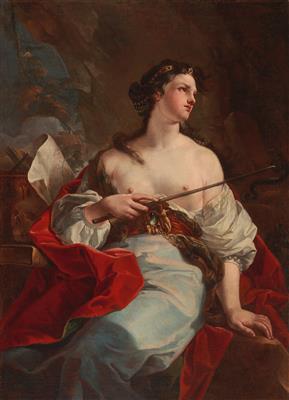Corrado Giaquinto and Workshop

(Molfetta 1703–1766 Naples)
Circe,
oil on canvas, 136 x 100 cm, framed
Provenance:
Private European collection
The present painting can be compared with a smaller canvas of the same subject by Corrado Giaquinto, conserved in the Pinacoteca Comunale Fortunato Duranti, Montefortino (inv. no. 23). This painting depicts a delicate yet majestic feminine figure who is holding a wand behind which there is a snake. On her left, there is a skull, a container, a book and what appears to be an astronomical map. The Montefortino painting has the same objects depicted. The figure was initially thought to be Saint Agatha, as the wand was thought to be a blade and therefore an allusion to the Saint’s martyrdom. She was then believed to be Medea, due to the comparison with another two works by Giaquinto which are located in a private collection. She was also thought to be a Sibyl or an Allegory (see M. Scolaro, Corrado Giaquinto. Il cielo e la terra, catalogo della mostra, Argelato 2005, pp. 230-231). Some also believed her to be Armida from Torquato Tasso’s Jerusalem Delivered because of the clothing, her regal posture and the wand with the snake, which was meant to bring evil in order to take vengeance on Rinaldo, who had abandoned her. The most accredited hypothesis, however, is that the female figure is Circe from the Odyssey since the elements accompanying her refer to evil forces. More specifically, the symbols relate to the magic arts: there is a mortar to prepare potions, a skull, a snake and a wand with which she transformed Ulysses’ companions into pigs.
The date in which the canvas in Montefortino was painted is also controversial. Some experts believe it to have been painted around the mid-1700s; while others think it dates to an earlier period (see M. Scolaro, ibid., 2005). This painting should in any case date to the maturity of Corrado Giaquinto, when the echoes of Maratti’s classicism were combined with a reinterpretation of the Baroque and a personal interpretation of the new spirit of Rococo.
An analogous version of this painting, which only differs from it by lacking the skull on the left, appeared on the market in 2009 (sale, Sotheby’s, New York, 29 January 2009, lot 180).
25.04.2017 - 18:00
- Odhadní cena:
-
EUR 40.000,- do EUR 60.000,-
Corrado Giaquinto and Workshop
(Molfetta 1703–1766 Naples)
Circe,
oil on canvas, 136 x 100 cm, framed
Provenance:
Private European collection
The present painting can be compared with a smaller canvas of the same subject by Corrado Giaquinto, conserved in the Pinacoteca Comunale Fortunato Duranti, Montefortino (inv. no. 23). This painting depicts a delicate yet majestic feminine figure who is holding a wand behind which there is a snake. On her left, there is a skull, a container, a book and what appears to be an astronomical map. The Montefortino painting has the same objects depicted. The figure was initially thought to be Saint Agatha, as the wand was thought to be a blade and therefore an allusion to the Saint’s martyrdom. She was then believed to be Medea, due to the comparison with another two works by Giaquinto which are located in a private collection. She was also thought to be a Sibyl or an Allegory (see M. Scolaro, Corrado Giaquinto. Il cielo e la terra, catalogo della mostra, Argelato 2005, pp. 230-231). Some also believed her to be Armida from Torquato Tasso’s Jerusalem Delivered because of the clothing, her regal posture and the wand with the snake, which was meant to bring evil in order to take vengeance on Rinaldo, who had abandoned her. The most accredited hypothesis, however, is that the female figure is Circe from the Odyssey since the elements accompanying her refer to evil forces. More specifically, the symbols relate to the magic arts: there is a mortar to prepare potions, a skull, a snake and a wand with which she transformed Ulysses’ companions into pigs.
The date in which the canvas in Montefortino was painted is also controversial. Some experts believe it to have been painted around the mid-1700s; while others think it dates to an earlier period (see M. Scolaro, ibid., 2005). This painting should in any case date to the maturity of Corrado Giaquinto, when the echoes of Maratti’s classicism were combined with a reinterpretation of the Baroque and a personal interpretation of the new spirit of Rococo.
An analogous version of this painting, which only differs from it by lacking the skull on the left, appeared on the market in 2009 (sale, Sotheby’s, New York, 29 January 2009, lot 180).
|
Horká linka kupujících
Po-Pá: 10.00 - 17.00
old.masters@dorotheum.at +43 1 515 60 403 |
| Aukce: | Obrazy starých mistrů |
| Typ aukce: | Salónní aukce |
| Datum: | 25.04.2017 - 18:00 |
| Místo konání aukce: | Wien | Palais Dorotheum |
| Prohlídka: | 15.04. - 25.04.2017 |
